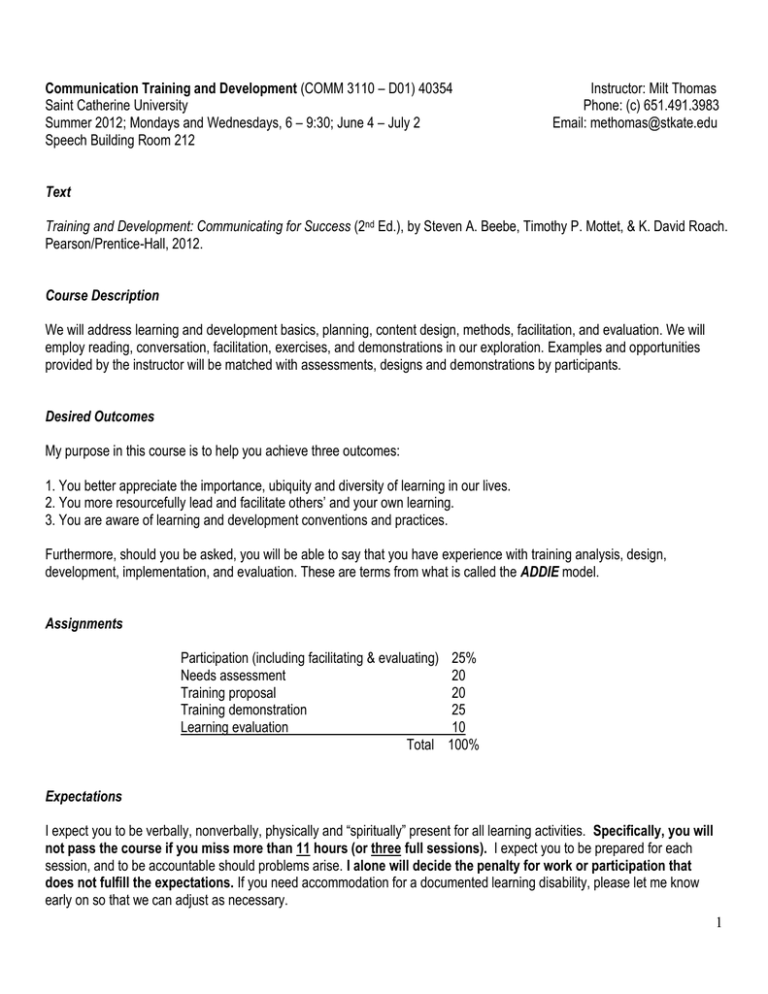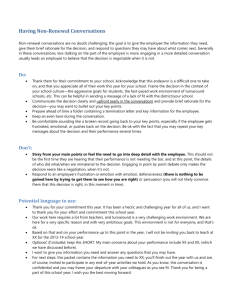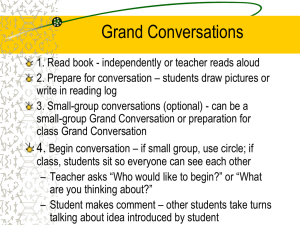
Communication Training and Development (COMM 3110 – D01) 40354
Saint Catherine University
Summer 2012; Mondays and Wednesdays, 6 – 9:30; June 4 – July 2
Speech Building Room 212
Instructor: Milt Thomas
Phone: (c) 651.491.3983
Email: methomas@stkate.edu
Text
Training and Development: Communicating for Success (2nd Ed.), by Steven A. Beebe, Timothy P. Mottet, & K. David Roach.
Pearson/Prentice-Hall, 2012.
Course Description
We will address learning and development basics, planning, content design, methods, facilitation, and evaluation. We will
employ reading, conversation, facilitation, exercises, and demonstrations in our exploration. Examples and opportunities
provided by the instructor will be matched with assessments, designs and demonstrations by participants.
Desired Outcomes
My purpose in this course is to help you achieve three outcomes:
1. You better appreciate the importance, ubiquity and diversity of learning in our lives.
2. You more resourcefully lead and facilitate others’ and your own learning.
3. You are aware of learning and development conventions and practices.
Furthermore, should you be asked, you will be able to say that you have experience with training analysis, design,
development, implementation, and evaluation. These are terms from what is called the ADDIE model.
Assignments
Participation (including facilitating & evaluating)
Needs assessment
Training proposal
Training demonstration
Learning evaluation
Total
25%
20
20
25
10
100%
Expectations
I expect you to be verbally, nonverbally, physically and “spiritually” present for all learning activities. Specifically, you will
not pass the course if you miss more than 11 hours (or three full sessions). I expect you to be prepared for each
session, and to be accountable should problems arise. I alone will decide the penalty for work or participation that
does not fulfill the expectations. If you need accommodation for a documented learning disability, please let me know
early on so that we can adjust as necessary.
1
Tentative Schedule
Please read the assignment before the date listed.
Date
Session
6/4
1
Introductions and orientation
6/6
2
Training and learning concepts;
“needs” assessment and task analysis
Ch. 1-3
6/11
3
Developing curriculum and content;
training trends and careers
Ch. 4-5, 12
6/13
4
Training methods, plans and delivery
Ch. 6, 8-9
6/18
5
Needs assessments due; guests
6/20
6
E-learning; delivery; assessing learning outcomes
6/25
7
Training proposals due; preparing for demonstrations
6/27
8
Training demonstrations; instructor evaluations
7/2
9
Training demonstrations
7/6
Topic
Reading
Ch. 7, 10, 11
No class session; Training evaluations due
2
Guidelines for Co-Facilitating Conversations about Reading Assignments
1. Remember that this is an informal exercise. You facilitate these conversations so that you can help determine what
is worth emphasizing and what can be glossed. If you facilitate well our learning, it can help your final (participation)
grade. If you are prepared and earnest, even if the conversation does not go well, you will not be penalized. So,
relax, and let the rest of us help.
2. This course is distinctive. The emphasis is on how you—uniquely—experience leadership and persuasion.
Compared with many courses, the focus is less on your grasp of “expert” ideas than it is on a perspective that you
generate. Therefore, we will “glide” (i.e., sashay, surf, jog, float) through a bunch of reading material in an all-tooshort time span. My hope is that you will encounter material—some parts of which will resonate more than other
parts—that will prompt you—in part as a result of comparison and contrast—to flesh out and articulate your own
distinctive perspective. Therefore, I want you to take seriously your engagement with each and every reading
assignment, but not in a time- and energy-intensive way. Make independent judgments about when to dwell,
explore and reflect and when to skim. The text is offered as a point of departure for your own perspective.
3. Your job is not to present, but to stimulate and guide a learning conversation. Think of ways to provide prompts
for dialogue, versus ways to “teach” us or review information from the reading material.
4. Coordinate well with your partners. Great facilitation starts with agreement about what one or more outcomes you
want to achieve together with participants. After that, consider what one or two moves you can make to help bring
about those outcomes.
It is probably not best to split off with each facilitator taking a chapter, because we do not have time to pore over
each chapter at length. If you decide to each take a chapter anyway, expect to ask one good, open-ended
questions about each chapter, with 10-15 minutes of conversation to follow.
5. Facilitate quality participation by all. Remember that some learn best by independent reflection, partnered by
conversation. Some learn best in one-on-one or small group exchanges, and some in large group dialogue. Some
focus on “why” questions; some on “what”; some on “how”; and some on “what if” questions. Some like to see or
watch to learn; some like to hear, and some like to do. Work to accommodate a wide range of participants and their
learning styles, using a “both/and” versus an “either/or” approach.
6. One important service you can provide yourself and others is to link the conversation and reflections to the final
course assignment—the Personal Leadership Plan. You can ask/address questions such as:
(1) To what extent can anything here contribute to a strong definition of leadership?
(2) To what extent can anything here contribute to my/your sense of mission/purpose?
(3) What communication-specific observations and tips are provided or suggested?
7. Be prepared to mention ideas from the reading material that you liked or agreed with, ones that you didn’t like or
agree with, and invite responses from others. Consider addressing concepts, arguments or illustrations that
confused you, and allow others to help clarify.
8. Determine what the thesis of the chapter/reading segment is, and the main points (subheadings with parallel
structure, bold print and italics are clues). You will likely choose not to address them explicitly, but know them.
9. Evaluate the material overall. What is your critical thesis? Would you give it a “B”? A “7” on a 1-10 scale? Why?
Why not higher or lower? This should help you to both: (1) generate some energy about the material, and (2) clarify
for yourself the extent to which—and how—the material might be useful to you.
3
Schedule for Facilitating Conversations on the Readings
Date
Chapter
6/6
1
Topic
Training concepts
Facilitator(s)
1. ______________________
2. ______________________
6/6
2
Learning concepts
1. ______________________
2. ______________________
6/6
3
“Needs” assessments
1. ______________________
2. ______________________
6/11
12
Training trends and careers
1. ______________________
2. ______________________
6/11
4
Developing training curricula
1. ______________________
2. ______________________
6/11
5
Developing training content
1. ______________________
2. ______________________
6/13
6
Training methods
1. ______________________
2. ______________________
6/13
8
Training plans
1. ______________________
2. ______________________
6/13
9
Training “delivery”
1. ______________________
2. ______________________
6/20
7
E-learning
1. ______________________
2. ______________________
6/20
10
Delivery
1. ______________________
2. ______________________
6/20
11
Assessing learning
1. ______________________
2. ______________________
4






